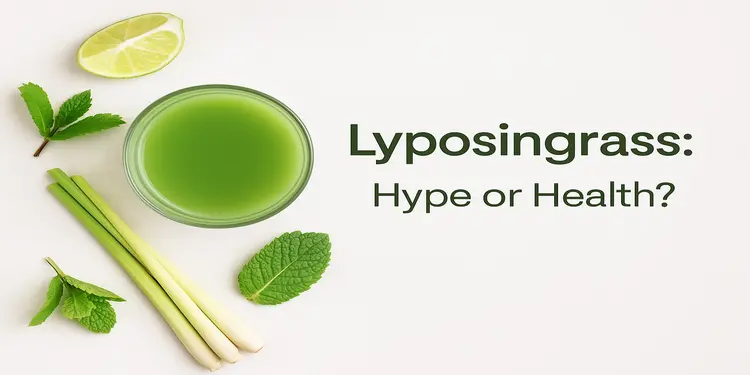Let’s be real, wellness trends come and go like TikTok dances. One minute it’s sea moss, next it’s chlorophyll drops, and now… Lyposingrass?
Yeah. That word had me blinking, too. Is it a plant? A protein? Something your grandma grows on her balcony? No idea.
But apparently, it’s blowing up on health blogs, Pinterest boards, and low-key sketchy Reddit threads. People are calling it the next big thing for detoxing, digestion, and even weight loss. Some say it’s “cleaner than celery juice.” Others say it’s nonsense in a cute package.
So, what is Lyposingrass? And is it worth your time?
Let’s dig in.
🌿 First off: What is Lyposingrass?
Okay, here’s the tea. Lyposingrass isn’t a plant you’ll find in your local grocery store. It’s more like a made-up brand term — a mashup of “lypo” (short for lipolysis, aka fat burning) and “grass” (to make it sound natural and herbal).
Most people online are linking Lyposingrass to:
- Fat-burning support
- Detox effects
- Anti-bloat benefits
- More “natural” energy without caffeine
But here’s the plot twist: there’s no official scientific backing for something called Lyposingrass. It’s not in any botanical database. It’s more likely a marketing name slapped onto a blend of herbs like lemongrass, dandelion, ginger, or green tea extract.
Yep. You’ve probably already had something like it… just not with a fancy rebrand.
💻 So why is it trending right now?
Three words: Aesthetic wellness marketing.
Seriously — the word Lyposingrass just sounds clean and cutting-edge. It’s showing up in:
- TikTok videos titled “My gut health glow-up 🧃”
- Instagram reels of girls sipping neon-green smoothies
- Wellness influencers unboxing powders with pale green branding and mysterious ingredient lists
It’s also been popping up in headlines like:
“Is Lyposingrass the Next Sea Moss?”
“What Everyone’s Drinking But No One Can Define”
It’s vague, new, and looks pretty in a glass — perfect viral formula.
🧪 What’s actually in Lyposingrass products?
Spoiler alert: Every product is different. Since Lyposingrass isn’t a real, regulated herb, brands are basically free to define it however they want.
Most “Lyposingrass” products include:
- Lemongrass – known for anti-inflammatory properties and digestion support
- Green tea extract – metabolism booster, packed with antioxidants
- Ginger root – classic anti-bloat, gut-friendly hero
- Dandelion – often used for mild detox or water weight support
- Chicory root or inulin – for prebiotic fiber
So yeah, the ingredients aren’t new — but the combo is being sold as something “never seen before.” Sneaky.
🧘♀️ Does it do anything?
Here’s where things get murky.
If you drink a Lyposingrass tea or smoothie, you might:
- Feel less bloated (thanks, ginger + lemon)
- Pee a lot more (hi, dandelion)
- Get a gentle energy boost (green tea)
- Think “wow, I’m so healthy right now” 😌
But is that magic? Probably not.
It’s just your gut feeling better because you’re finally giving it something hydrating, anti-inflammatory, and clean. That’s a win, but it’s not a miracle.
🤔 Is it a scam?
Not exactly. It’s more like a branding flex than a lie.
Imagine if someone took green juice, added mint, and called it “MetaboMint.” That’s kind of what Lyposingrass is. The ingredients aren’t bad, but the hype vs. science gap is wide.
Also, many Lyposingrass brands don’t list exact dosages or full ingredient transparency. That’s a red flag 🚩.
✨ Should you try it?
Sure — if:
- You like herbal stuff
- You’re looking for a caffeine-free boost
- You’re okay spending $15–$30 on a nice-feeling placebo
- You don’t expect it to replace, like, water and vegetables
But don’t try it if:
- You have digestive sensitivities (especially to herbs like dandelion or chicory)
- You’re pregnant or on meds — always check with a doc
- You’re expecting fast fat loss from a tea. That’s not how bodies work.
💬 Real-life chat: My friend tried it
So my friend Jess bought a Lyposingrass blend after seeing a TikTok. It was a powder you mixed into water. She said it tasted like “minty lemon ginger spa water with a side of regret.”
BUT — she also said it helped her cut back on snacking at night. Whether that was a placebo or the green tea doing its thing, who knows? But she felt good drinking it, so… win?
Her verdict: “Would I buy it again? Probably not. But did I enjoy pretending I was a wellness queen for a week? Yes.” 😂
🚀 Here’s what to do instead of chasing every trend
If you love trying new things, cool, go sip that green powder. But if you’re just trying to feel better, here are 5 things that work:
- Drink real water (not just green water)
- Move your body — even a 10-minute walk
- Add fiber — your gut loves you for this
- Ditch the all-or-nothing mindset
- Find what feels sustainable, not what’s trending
That’s wellness, no branding needed.
🧡 So… is Lyposingrass worth the hype?
Honestly? It’s harmless fun with some low-key benefits.
If it makes you feel more energized or reminds you to take care of yourself, go for it.
Just don’t expect a miracle in a mug. And don’t let a mystery word boss around your self-worth.
You’re already doing great.
Quick DMs you’d send me.
Q: Wait, is Lyposingrass even real?
Not officially. It’s more of a trendy label slapped on a mix of herbal ingredients.
Q: Can it help with weight loss?
Maybe indirectly — like reduced bloating or better digestion — but it won’t burn fat by itself.
Q: Is it dangerous?
Not usually, but check labels. Some blends sneak in caffeine or sketchy herbs. And always check with your doc if you’re on medication.
Q: Would you drink it?
Honestly? I already have all those ingredients in my kitchen. But if someone gave me a cute Lyposingrass tin… I’d try it for the ✨aesthetic✨.


